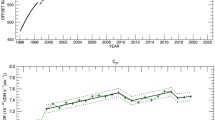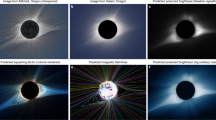Abstract
In late 2014, when the current Solar Cycle 24 entered its declining phase, the white-light corona as observed by the LASCO-C2 coronagraph underwent an unexpected surge that increased its global radiance by 60%, reaching a peak value comparable to the peak values of the more active Solar Cycle 23. A comparison of the temporal variation of the white-light corona with the variations of several indices and proxies of solar activity indicate that it best matches the variation of the total magnetic field. The daily variations point to a localized enhancement or bulge in the electron density that persisted for several months. Carrington maps of the radiance and of the HMI photospheric field allow connecting this bulge to the emergence of the large sunspot complex AR 12192 in October 2014, the largest since AR 6368 observed in November 1990. The resulting unusually high increase of the magnetic field and the distortion of the neutral sheet in a characteristic inverse S-shape caused the coronal plasma to be trapped along a similar pattern. A 3D reconstruction of the electron density based on time-dependent solar rotational tomography supplemented by 2D inversion of the coronal radiance confirms the morphology of the bulge and reveals that its level was well above the standard models of a corona of the maximum type, by typically a factor of 3. A rather satisfactory agreement is found with the results of the thermodynamic MHD model produced by Predictive Sciences, although discrepancies are noted. The specific configuration of the magnetic field that led to the coronal surge resulted from the interplay of various factors prevailing at the onset of the declining phase of the solar cycles, which was particularly efficient in the case of Solar Cycle 24.













Similar content being viewed by others
Notes
References
Allen, C.W.: 1973, Astrophysical Quantities, 3rd edn. University of London, The Athlon Press, London. ADS .
Barlyaeva, T., Lamy, P., Llebaria, A.: 2015, Mid-term quasi-periodicities and solar cycle variation of the white-light corona from 18.5 years (1996.0 – 2014.5) of LASCO observations. Solar Phys. 290, 2117. DOI .
Baumbach, S.: 1937, Strahlung, Ergiebigkeit und Elektronendichte der Sonnenkorona. Astron. Nachr. 263(6), 121. DOI .
Brueckner, G.E., Howard, R.A., Koomen, M.J., Korendyke, C.M., Michels, D.J., Moses, J.D., Socker, D.G., Dere, K.P., Lamy, P.L., Llebaria, A., Bout, M.V., Schwenn, R., Simnett, G.M., Bedford, D.K., Eyles, C.J.: 1995, The Large Angle Spectroscopic Coronagraph (LASCO). Solar Phys. 162, 357. DOI .
Lamy, P., Barlyaeva, T., Llebaria, A., Floyd, O.: 2014, Comparing the solar minima of cycles 22/23 and 23/24: The view from LASCO white-light coronal images. J. Geophys. Res. 119, 47. DOI .
Munro, R.H., Jackson, B.V.: 1977, Physical properties of a polar coronal hole from 2 to 5 solar radii. Astrophys. J. 213, 874. DOI .
Quémerais, E., Lamy, P.: 2002, Two-dimensional electron density in the solar corona from inversion of white light images application to SOHO/LASCO-C2 observations. Astron. Astrophys. 393, 295. DOI .
Saito, K., Makita, M., Nishi, K., Hata, S.: 1970, A non-spherical ax-symmetric model of the solar corona of minimum type. Ann. Tokyo Astron. Obs. 12, 53. ADS .
Sheeley, N.R. Jr., Wang, Y.M.: 2014, Coronal inflows during the interval 1996 – 2014. Astrophys. J. 797, 10. DOI .
Sheeley, N.R. Jr., Wang, Y.M.: 2015, The recent rejuvenation of the Sun’s large-scale magnetic field: A clue for understanding past and future sunspot cycles. Astrophys. J. 809, 113. DOI .
Shibata, K., Ishii, T., Kawamura, A.: 2015, Why big sunspot 12192 did not produce CME? In: Japan Geoscience Union Meeting, abstract number PEM07-32_E.
Sun, X., Bobra, M.G., Hoeksema, J.T., Liu, Y., Li, Y., Shen, C., Couvidat, S., Norton, A.A., Fisher, G.H.: 2015, Why is the great solar active region 12192 flare-rich but CME-poor? Astrophys. J. Lett. 804, L28. DOI .
van de Hulst, H.C.: 1950, The electron density of the solar corona. Bull. Astron. Inst. Neth. 11, 135. ADS .
Vibert, D., Peillon, C., Lamy, P., Frazin, R.A., Wojak, J.: 2016, Time-dependent tomographic reconstruction of the solar corona. Astron. Comput. 17, 144. DOI .
Wang, Y.M., Sheeley, N.R. Jr.: 2003, On the fluctuating component of the Sun’s large-scale magnetic field. Astrophys. J. 590, 1111. DOI .
Acknowledgements
We acknowledge fruitful discussions with N. R. Sheeley, Y.-M. Wang, and R. Howard (NRL). We are grateful to Y.-M. Wang for providing the total and open magnetic fields data. This study makes use of the MHD models of Predictive Science Inc., and we thank J. Linker for several clarifications. The LASCO-C2 project at the Laboratoire d’Astrophysique de Marseille is funded by the Centre National d’Etudes Spatiales (CNES). LASCO was built by a consortium of the Naval Research Laboratory, USA, the Laboratoire d’Astrophysique de Marseille (formerly Laboratoire d’Astronomie Spatiale), France, the Max-Planck-Institut für Sonnensystemforschung (formerly Max Planck Institute für Aeronomie), Germany, and the School of Physics and Astronomy, University of Birmingham, UK. SOHO is a project of international cooperation between ESA and NASA.
Author information
Authors and Affiliations
Corresponding author
Ethics declarations
Disclosure of Potential Conflicts of Interest
The authors declare that they have no conflicts of interest.
Electronic Supplementary Material
Below is the link to the electronic supplementary material.
Rights and permissions
About this article
Cite this article
Lamy, P., Boclet, B., Wojak, J. et al. Anomalous Surge of the White-Light Corona at the Onset of the Declining Phase of Solar Cycle 24. Sol Phys 292, 60 (2017). https://doi.org/10.1007/s11207-017-1089-0
Received:
Accepted:
Published:
DOI: https://doi.org/10.1007/s11207-017-1089-0




